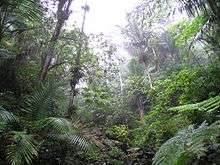United States National Forest
National Forest is a classification of protected and managed federal lands in the United States. National Forests are largely forest and woodland areas owned collectively by the American people through the federal government, and managed by the United States Forest Service, a division of the United States Department of Agriculture.

_(2).jpg)
History
The National Forest System was created by the Land Revision Act of 1891, which was signed under the presidency of Benjamin Harrison. It was the result of concerted action by Los Angeles-area businessmen and property owners who were concerned by the harm being done to the watershed of the San Gabriel Mountains by ranchers and miners. Abbot Kinney and forester Theodore Lukens were key spokesmen for the effort.
Geography
In the United States there are 155 National Forests containing almost 190 million acres (297,000 mi2/769 000 km2) of land. These lands comprise 8.5 percent of the total land area of the United States, an area about the size of Texas. Some 87 percent of National Forest land lies west of the Mississippi River in the mountain ranges of the Western United States. Alaska has 12 percent of all National Forest lands.
The U.S. Forest Service also manages all of the United States National Grasslands, and around half of the United States National Recreation Areas.
There are two distinctly different types of forests within the National Forest system.
- Those east of the Great Plains in the Midwestern and Eastern United States were primarily acquired by the federal government since 1891, and may be second growth forests. The land had long been in the private domain and sometimes repeatedly logged since colonial times, but was purchased by the United States government in order to create new National Forests.
- Those west of the Great Plains in the Western United States, though established since 1891, are primarily on lands with ownership maintained by the federal government since the U.S. acquisition and settling of the American West. These are mostly lands that were kept in the public domain, with the exception of inholdings and donated or exchanged private forest lands.
Management
Land management of these areas focuses on conservation, timber harvesting, livestock grazing, watershed protection, wildlife, and recreation. Unlike national parks and other federal lands managed by the National Park Service, extraction of natural resources from national forests is permitted, and in many cases encouraged. However, the first-designated wilderness areas, and some of the largest, are on National Forest lands.
There are management decision conflicts between conservationists and environmentalists, and natural resource extraction companies and lobbies (e.g. logging & mining), over the protection and/or use of National Forest lands. These conflicts center on endangered species protection, logging of old-growth forests, intensive clear cut logging, undervalued stumpage fees, mining operations and mining claim laws, and logging/mining access road-building within National Forests. Additional conflicts arise from concerns that the grasslands, shrublands, and forest understory are grazed by sheep, cattle, and, more recently, rising numbers of elk and mule deer due to loss of predators.
Many ski resorts and summer resorts operate on leased land in National Forests.
See also
- List of U.S. National Forests
- United States National Grassland
- National Forests of the United States topics
- State forest
- National Forest Management Act of 1976
- Protected areas of the United States
External links
| Wikimedia Commons has media related to National Forests of the United States. |